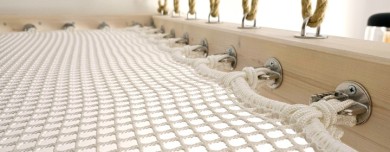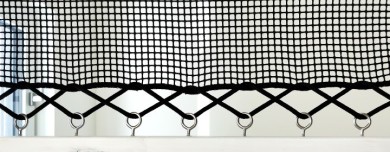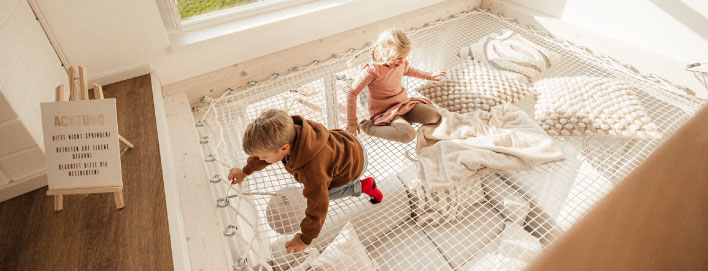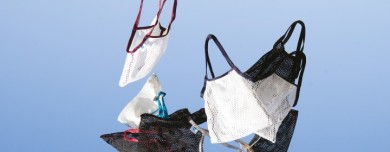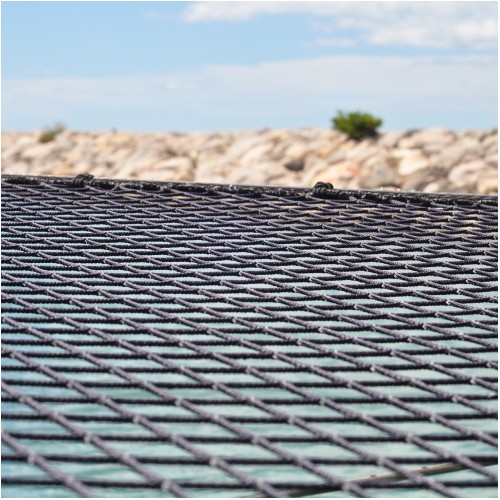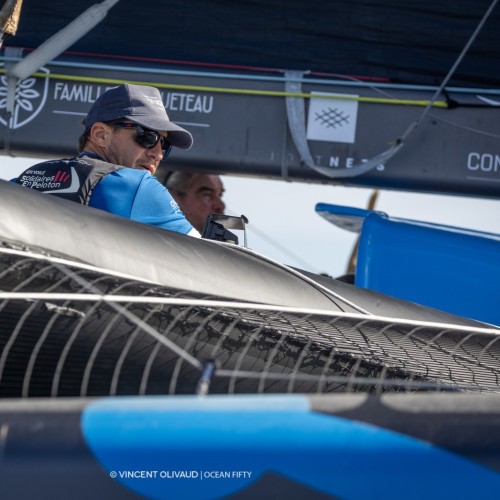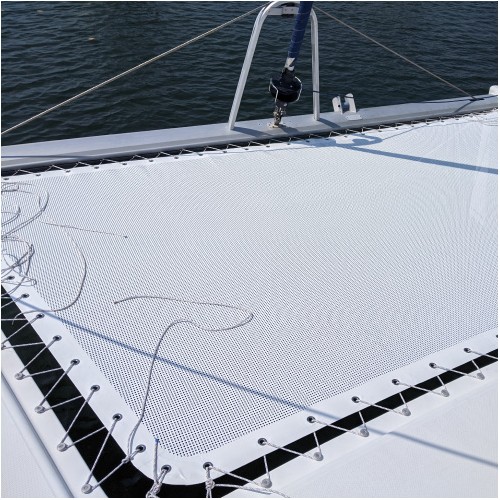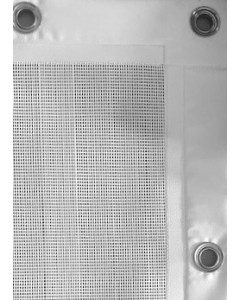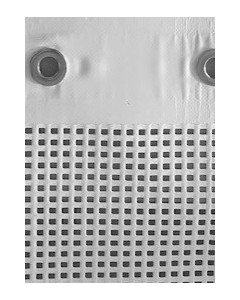Net or technical canvas for a liveaboard or custom-made multihull... together we will find the best solution for you and your boat.
Our customers’ requirements
For LOFTNETS, being able to offer the right net or technical canvas comes above all from the search for the best characteristics in our materials, based on our customers’ specifications and needs. The criteria that matter most to customers vary and include:
- Transparency and permeability
- Resistance
- Ability to withstand conditions at sea
- Comfort
- Design
- Price
LOFTNETS takes all of these criteria into account when designing its catamaran trampolines in order to fully respond to every need.
Find out more about our products, the materials we use and their technical specifications to help you make your choice.
Catamaran trampolines: net or technical canvas?
Our research among various suppliers, as well as feedback and discussions with professional and private skippers, has led us to develop a range of braided mesh nets and technical canvases.
In the table below we compare the different characteristics of braided mesh and technical canvases:
| Braided mesh |
Technical canvas |
|
| Wave permeability |
Excellent | Good |
| UV-light treatment |
Yes | Yes |
| Lifespan* | 3-4 years | 6-8 years |
| Comfort | Very good | Excellent |
| Weight | Low | Moderate |
| Border | Bolt rope / Double bolt rope | Eyelets / Tunnel |
*Tested with boat rental companies in the West Indies and French Polynesia.
Braided mesh
Rope catamaran nets are traditionally used for liveaboard multihulls. Their main advantage is how open they are, coupled with their low wave-resistance and good water permeability. As mesh and braiding techniques have evolved, braided meshes have been developed that are just as robust as knotted meshes, and offer incredible levels of comfort.
Our selection of trampoline nets for multihulls includes various sizes of thread and meshes, as well as different braiding systems. The nets listed below are made from polyester. This material is made to last and suitable for use at sea, where they will be exposed to high levels of UV and seawater.
Our braided mesh nets are extremely comfortable and offer good water permeability when sailing. As with all our catamaran nets, this type of mesh features a high-performance UV-light treatment. Made from polyester, this ideal material for catamaran trampolines offers excellent resistance to the elements at sea and will ensure you many years of use.
Spotlight on LOFTNETS’ exclusive Marine 3S® polyester mesh
More resistant and less elastic than a standard polyester, Marine 3S® polyester by LOFTNETS was named in reference to its technical characteristics: ‘Marine’ refers to its impressive resistance to wind, sun and salt, and 3S to the three Ss: Strong, Soft and Sunproof.
High-tenacity polyester offers a number of benefits, including a lower stretch factor than standard polyester, meaning it will stretch very little when used. Thanks to a special heat-setting process, it can tolerate high UV exposure and is resistant to seawater. LOFTNETS Marine 3S® mesh is available in 15 mm, 20 mm and 30 mm.
| 15 mm | 20 mm | 30 mm | |
| Thread diameter |
2,5 mm | 3,5 mm | 4 mm |
| Colors available |
white, black | grey | white, black |
Dyneema® braided meshes
Our pre-stretched 50 mm Dyneema® nets are primarily designed for racing catamarans. Four times more resistant than a polyester net of the same diameter, the Dyneema® SK78 will also last two to three times longer.
This material also has a very low stretch factor (-1%) thanks to its polyurethane treatment and a heated pre-stretching process carried out during manufacture. This means your net will remain very taut without needing to be retensioned during its life. We recommend using a Dyneema® tension rope (Ø 4 mm or Ø 6 mm) to maintain these properties during lacing.
Note that this type of net is more expensive than a braided mesh net.
Technical canvas nets for multihulls
The main benefit of trampolines made from technical canvas is the level of comfort they offer. Barefoot, lying, or sitting, technical canvas trampolines are a great place to relax. This enables them to significantly increase the usable space on your boat (by almost 20%) for sailing primarily focused on leisure.
Although they use the same design principle, technical fabrics vary and have different characteristics suited to different uses for each model of multihull.
The material, meshing and openness of meshes are just some of the parameters that will vary from product to product. These fabrics are commonly referred to as mesh fabrics. Technical canvas catamaran nets are bordered by a reinforced edge often composed of plain canvas and a strap. This technique can be used for many different complex shapes and different fastener systems using eyelets, bolt ropes, rods, slats and straps. These canvases also make it possible to have no tension system on one or more sides of the net.
High-resistance mesh: TEC400
This material offers excellent wave permeability, meaning high-level breaking and damage resistance.
Our specifications are based on the ability of a canvas and its fastener system to support the weight of an entire crew. Another notable benefit is that this canvas can be bonded together in order to cover large surface areas.
High-resistance mesh: TEC600
The technical design and dimensions of the materials in this product’s composition make this an ultra-resistant fabric capable of supporting five tons per m². This fabric is ideal for trampolines on large ships from 35-footers to large multihulls. The open mesh helps reduce wave-resistance.
This canvas can also be bonded together in order to cover large surface areas.
Technical characteristics for each product:
| TEC400 | TEC600 | |
| Thread material |
1100 Dtex –PES HT | 1100 Dtex –PES HT |
| Coating material |
1100 Dtex+PVC | 1670 Dtex+PVC |
| Weight/m² | 820 g/m² | 1000 g/m² |
| Breaking resistance |
300/300 daN/5cm | 400/250 daN/5cm |
| Tear resistance | 60/60 daN/5cm | 100/55 daN/5cm |
| T° |
-30°C / +70°C | -30°C / +70°C |
| Porosity | 19% | 24% |
| Color | black, white | white |
| UV resistance |
very good | very good |
| Use | liveboard multihull | 35-80 foot liveboard multihull |


